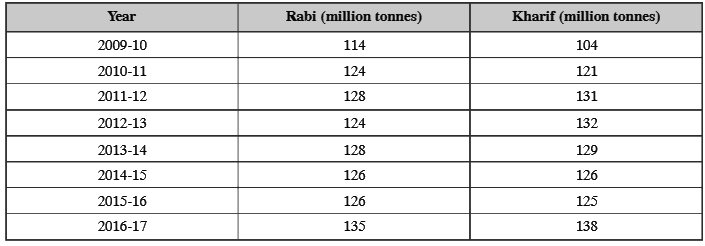Class 9 Science Chapter 12 Case Based Questions - Improvement in Food Resources
Q1: Read the given passage and answer the questions based on the table and related studied concepts.
With a population of 1.3 billion, India is the world’s second most populous country. It is the seventh largest country in the world with an area of 3.288 million sq kms. Agriculture, with its allied sectors, is the largest source of livelihoods in India. 70 percent of its rural households still depend primarily on agriculture for their livelihood, with 82 percent of farmers being small and marginal. In 2017-18, total food grain production was estimated at 275 million tonnes. India is the largest producer (25% of global production), consumer (27% of world consumption) and importer (14%) of pulses in the world. India’s annual milk production was 165 MT (2017-18), making India the largest producer of milk, jute and pulses, and with world’s second-largest cattle population 190 million. It is the second-largest producer of rice, wheat, sugarcane, cotton and groundnuts, as well as the second-largest fruit and vegetable producer, accounting for 10.9% and 8.6% of the world fruit and vegetable production, respectively. Year wise food grain production data in India are given below: (i) How does use of fertilizers improve crop production?
(i) How does use of fertilizers improve crop production?
Ans: To maintain soil fertility, regular dose of nutrients in the form of fertilisers are added. These fertilisers provide the necessary nutrients in the soil and thereby increases the fertility of the soil.
(ii) What is the significance of animal husbandry?
Ans:
- Improvement of breeds of the domesticated animals.
- Increasing the yield of foodstuffs such as milk, egg and meat.
(iii) What is the basic objective in mixed cropping?
Ans: Basic objective of mixed cropping is to minimise the risk of crop failure due to adverse weather condition
(iv) Why is chemical methods of controlling pests not considered good?
Ans: The chemicals sprayed on plants to control pests causes environmental pollution. Some part of the chemical gets penetrated into the grains and is harmful to animals and human being.
Q2: Read the given passage and answer the questions based on the passage and related studied concepts.
There is concern that agricultural production in developing countries will cause environmental threats in the future, as production will have to increase to satisfy the growing demand for food. Intensification leads to high inputs of nutrients in the form of mineral fertilizers and animal feed. Important parts of these inputs leak from the system in the form of nutrient leaching to groundwater and gaseous losses to the atmosphere. Pressure on the existing agricultural land may increase by growing demand for productive land and degradation of the existing agricultural land base. Expansion of agriculture generally leads to massive deforestation.
There is an interactions between livestock production, crop production and land use. The link between livestock and crop production is through the demand for animal feedstuffs. As the world population is expected to stabilise in the second half of the twenty-first century, the scenarios must cover a period of 50-100 years to include the impacts of human population. Not all environmental consequences can be quantitatively evaluated. World agriculture is currently responsible for more than half of the atmospheric increase of nitrous oxide (N2O), two thirds of the global ammonia (NH3) input into the atmosphere, and 40% of global methane (CH4) emissions. These compounds play important roles in atmospheric chemistry, ozone depletion, aerosol formation and greenhouse warming.
(i) What is the significance of animal husbandry?
Ans:
(a) Improvement of breeds of the domesticated animals.
(b) Increasing the yield of food-stuff such as milk, egg and meat.
(ii) Name a method by which we can improve the desired characteristics of animals.
Ans: Selective breeding.
(iii) What are the harmful effects of pesticides and fertilisers over a long period of time on soil?
Ans: Use of pesticides and fertilisers over a long period make the soil either too alkaline or too acidic and thereby destroy the soil fertility. Microorganisms of soil are harmed by fertilisers and also pollute the underground water, lakes and rivers
(iv) List any two factors for which crop variety improvement is done.
Ans: Two factors for which crop variety improvement is done are biotic and abiotic resistance and change in maturity duration.



















